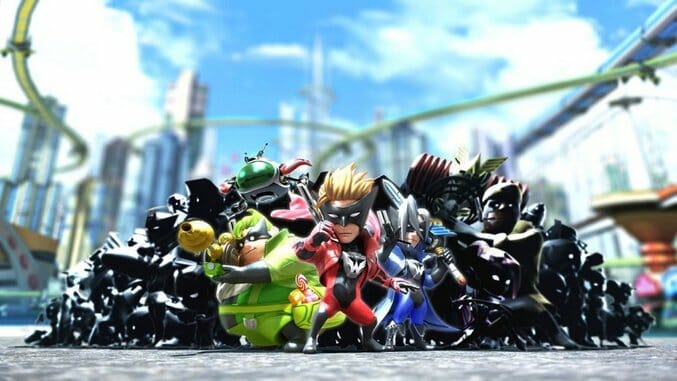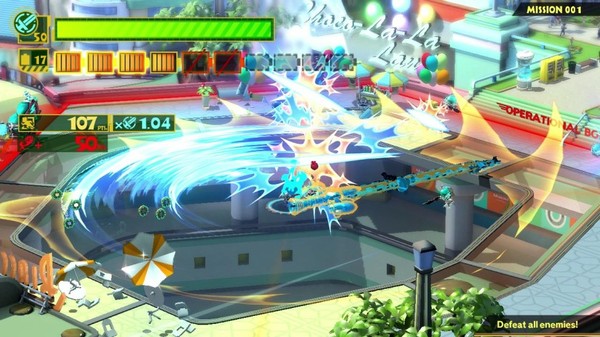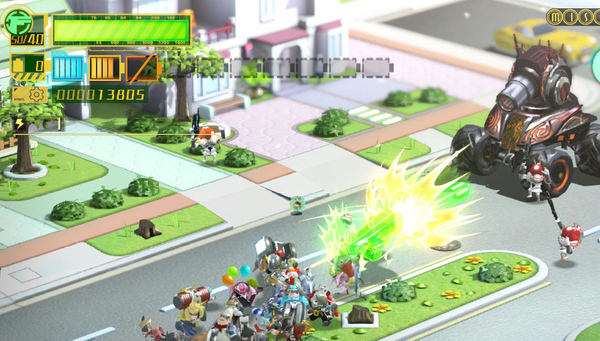
Platinum Games feels like it has something to prove with The Wonderful 101. Despite the studio making a name for itself with successes like Bayonetta and Vanquish, for many fans Platinum Games is still thought of as the Capcom castoffs that were once Clover Studio. Just a quick glance at The Wonderful 101 director and Platinum Games founder Hideki Kamiya’s twitter feed reveals a deluge of fans living in the past and asking about the next Viewtiful Joe or Okami.
While looking at Mr. Kamiya’s twitter feed you’ll also notice that he has grown increasingly irritated with those fans, with helpful responses like “Ask Capcom” and sometimes more colorful fare like the occasional “fuck off.”
So it seems that with The Wonderful 101, Platinum Games set out to create the perfect eulogy for Clover Studio—a game that would satisfy nostalgic fans, and hopefully shut them up in the process so Platinum could move on. And in that regard, it succeeds spectacularly.
The setup for The Wonderful 101 plays off of super sentai shows like Ultraman and Power Rangers, featuring a team of 100 superheroes from across the globe who are sworn to protect Earth from the evil GEATHJERK. Yes, the bad guys put the word “jerk” right in their own name, and the heroes have similarly one-note personalities as is typical of the genre.
Though there are 100 heroes only seven of them actually matter, which is to say they offer a unique weapon for combat and get speaking roles in the story. Wonder Red fights with fists while Wonder Blue carries a sword, and as you accumulate other heroes you’ll gain access to a gun, whip, hammer, claws and a time-distorting bomb. The rest of the heroes get unique names and costumes like Wonder Chef and Wonder Bath, the latter of which wears a claw foot bathtub as a helmet, but each carry the same weapon as one of the lead seven so they become indistinguishable in practice.
Super sentai teams usually combine their abilities to form giant all-powerful robots, and The Wonderful 101 has some fun with that trope by literally using your teammates’ bodies to form the weapons. The larger your team of followers, the larger and more powerful your weapons can be, complete with tiny hero limbs comically dangling out of the sides.
Just from the premise alone, glimpses of Viewtiful Joe and God Hand are showing through in The Wonderful 101’s visual style and tongue in cheek humor. But it’s the combat where The Wonderful 101 becomes a true tribute to Clover Studio.
Combat is deceptively complex, and only grows more layers as the game goes on. Your basic attack is the unite morph, the aforementioned weapon o’ heroes, which you can use to smack enemies with the A button. Each weapon has its own advantages and weaknesses, like the sword’s crowd control and the whip’s ability to attack spike-covered enemies, so picking the right weapon for each situation is key.
Like Okami, you need to master drawing various symbols in order to use the unite morphs. This is performed either with the gamepad’s touch screen or the right analog stick, though I found the stick to be faster without needing to take my eyes off of the screen. The symbols are fairly simple—a circle for Wonder Red’s fist, a straight line for Wonder Blue’s sword, a right angle for Wonder Green’s gun—and the larger you draw them the larger the weapon will be.
Drawing the unite morphs definitely takes some getting used to, and the game helpfully slows time while drawing so you aren’t completely vulnerable to enemies, but by the third mission I had gotten the hang of the system and was able to switch weapons mid-combo for creative and satisfying enemy take downs.
But that is only the start of your combat abilities. Pressing the X button pushes your swarm of heroes at an enemy, where they climb and kick to build up your combo count and weaken enemy defenses for your unite morph attacks. You can also press X after drawing a unite morph symbol to unleash that weapon under A.I. control for a short time. You can send out up to four additional unite morphs at once, and when you add your own unite morph weapon in the equation you get a satisfyingly deep brawler that rewards players who experiment and try to push its systems to their limit.
Huh, that last description sounds an awful lot like God Hand. Anyway, carrying on.
Unite morphs are also used outside of combat, with each weapon acting as a tool to open a type of door or find secret passages. You’ll also stretch lines of heroes across chasms to build bridges, line up against a wall for a ladder and draw a triangle to create a hang glider in certain situations. You can even recruit civilians by drawing a circle around them, giving them tiny masks so they can join your hero mob and help pump up your attacks.
In between levels you can use the coins earned in combat at the wonderful mart to unlock new skills and abilities. Like Viewtiful Joe’s between level shop these upgrades range from essentials that should be unlocked immediately, like the ability to block and dodge attacks, to augments like increasing the speed of unite morph drawings or restoring a little health every time you successfully block.
The Wonderful 101 is a game you’ll be playing for a long time. The main campaign carries across nine missions along with a prologue and lengthy epilogue. Missions are made up of three levels that can span 20 minutes to an hour each. The third level of each mission is always a protracted boss battle of some kind, following the fight through multiple phases that could shift from a chase across crumbling platforms to a Punch-Out-style boxing match while piloting a giant robot.
While the game is especially referential to Clover’s past works, the Punch-Out boss is an example of how Platinum Games also frequently mixes up the level design with nods to classics, including Zaxxon and Star Fox. I especially got a kick out a later level where I was flying through space shooting aliens, and when I flew near the bottom of the screen my character suddenly began running on a ground that wasn’t there simply because that’s how Space Harrier did it.
The Wonderful 101 could very well be the most videogamey game that ever videogamed. And since those references take the form of genuinely fun gameplay instead of cheap one-off jokes it is able to wear that distinction as a badge of honor.
Now, earlier I said that The Wonderful 101 perfectly encapsulates Clover Studio, and it’s important to remember that along with their cult following, Clover’s games always had their fair share of faults and eccentricities. Viewtiful Joe and its sequel were uncompromisingly difficult, Okami dragged on a bit longer than it needed to and God Hand was just, well, God Hand.
The camera is The Wonderful 101’s major Achilles’ heel, using an awkward isometric view that can make it difficult to judge where your lead character is in relation to enemies and the environment. While still acclimating to complex combat you’re bound to suffer quite a few deaths due to accidentally standing in an enemy’s attack path.
Even more frustrating are the times when The Wonderful 101 decides it wants to pretend at being a platformer even though the camera makes accurate jumping about as easy as threading a live anaconda through a cardboard tube. Same goes for trying to fly the hang glider across a gap without a shadow on the ground for spatial reference.
There is also the matter of how the Wii U’s gamepad is implemented that raises an eyebrow. For the most part it works well for menu navigation and drawing unite morph symbols on the touch screen, or at the very least it’s easy to ignore if you prefer using the right analog stick. But every once in a while your band of heroes will enter a building or cave and the inside will play out on your controller. The camera angle then switches from a fixed isometric view to hovering behind your lead character, and you can tilt the gamepad to look around.
This is perhaps the worst way to control a camera, as the gamepad’s gyroscope constantly resets and forces you to make increasingly grand gestures with your hands simply to avoid looking straight at the ground. It doesn’t help that these sections are always in tightly enclosed spaces so most attempts to move the camera also involve level geometry or the swarm of following heroes getting in the way. Most of these segments also involve interaction between the action on the TV screen and the gamepad, so if you opt to play just on the gamepad you either have to constantly switch between which screen is shown or use an awkward picture-in-picture mode.
As a special bonus to annoy those who try to play on the gamepad without a TV, for some reason in that mode you can’t actually use the touch screen for drawing unite morphs. Yes, that is precisely when it would make the most sense to draw using the touch screen since you wouldn’t have to look away from the action. No, the game still won’t let you do it.
The Wonderful 101 also makes little effort to actually explain all of the intricacies and complexity of its combat, which creates a huge difficulty barrier when first starting out. I had the benefit of seeing the game at trade shows for the past two years, playing demos with a developer nearby who offered helpful strategies if it seemed like I was struggling. So I already had a grasp on how to play before even loading up the full game.
The actual in-game tutorials though make little mention of some fundamental strategies. The vital assist attacks with the X button are given only the briefest and most incomplete of explanations, and you’re left to trial and error to discover proper timing for the block ability as well as which enemy attacks are actually unblockable and require a quick dodge instead.
Since you’ll die a lot in The Wonderful 101, it’s good to note that the game has an interesting way of balancing the penalty for dying. On the one hand, each death takes a huge chunk out of your score at the end of the level, giving you a lower rank and making it harder to buy new upgrades at the wonderful mart.
On the other hand, you respawn at the exact moment that you died, so any enemies you’ve defeated stay dead and any enemies who were still alive are just as hurt as when you left them. The same goes for boss battles, so even though the game is extremely challenging it at least mitigates the typical frustration of replaying the same section over and over again after screwing up.
The fact that deaths don’t hamper your progress is in large part because Platinum clearly wants players to be able to finish The Wonderful 101. That is because in the end it is literally the Platinum Games logo that saves the day. After playing through at least 20 hours of gameplay that drew heavy inspiration from games in Clover’s past, it is the power of Platinum that overshadows everything to achieve victory.
Yes, The Wonderful 101 is a love letter to fans who fondly remember Clover Studio. But it also expresses another equally heartfelt sentiment to those fans: a plea for fans to let Platinum Games create new experiences unshackled to the weight of the past. Or, as Hideki Kamiya himself has often put it more succinctly on Twitter: “Fuck off.”
The Wonderful 101 was developed by Platinum Games and published by Nintendo. It is available on the Wii U.
Scott Nichols is freelance writer from Chicago, where he is the US Gaming Reporter for Digital Spy and writes about games far and wide across the internet. He also occasionally maintains his blog at Gamerly Musings and frequently makes sarcastic remarks on twitter as @Duckols.”

